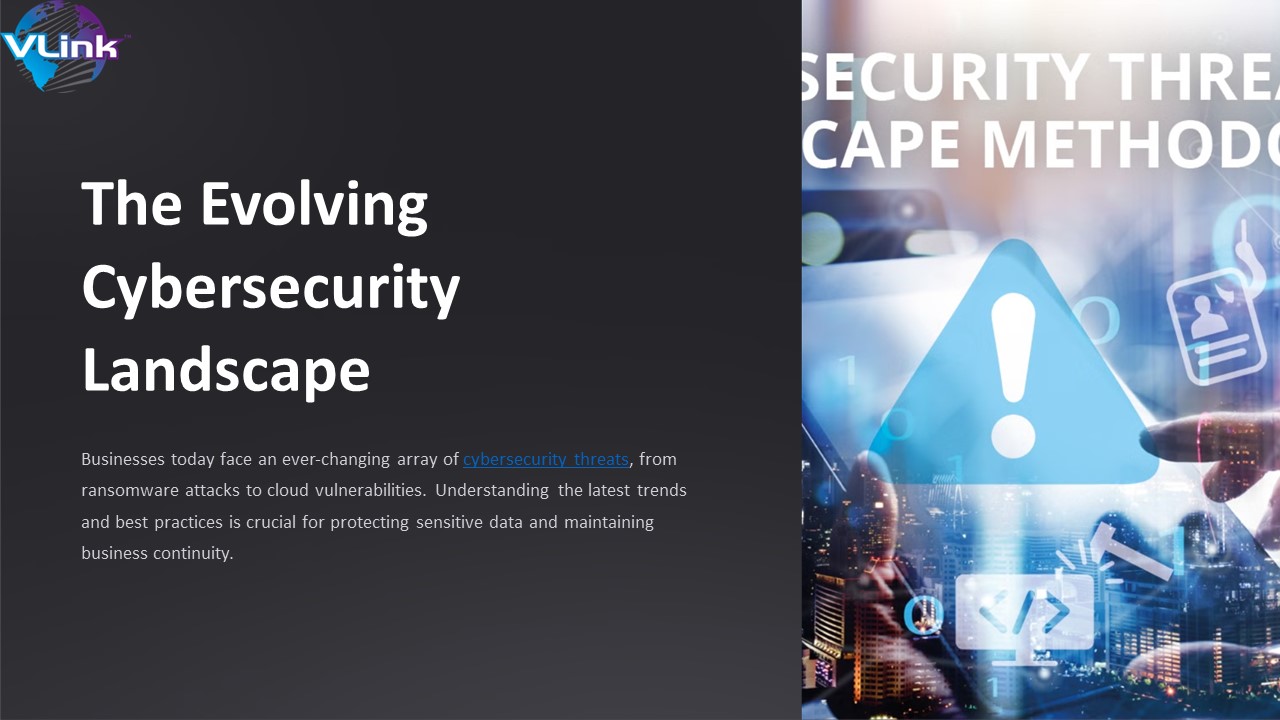The-Evolving-Cybersecurity-Landscape.pptx - PowerPoint PPT Presentation
Title:
The-Evolving-Cybersecurity-Landscape.pptx
Description:
The Evolving Cybersecurity Landscape" presentation delves into the dynamic realm of digital security, exploring emerging threats, trends, and strategies. Through insightful analysis and practical insights, it equips audiences with the knowledge and tools to navigate evolving cyber risks effectively, safeguarding assets and preserving trust in an increasingly interconnected world. – PowerPoint PPT presentation
Number of Views:8
Title: The-Evolving-Cybersecurity-Landscape.pptx
1
The Evolving Cybersecurity Landscape
Businesses today face an ever-changing array of
cybersecurity threats, from ransomware attacks to
cloud vulnerabilities. Understanding the latest
trends and best practices is crucial for
protecting sensitive data and maintaining
business continuity.
2
Ransomware Attacks
- Ransomware is a type of malicious software that
encrypts a victim's files and demands a ransom
payment to restore access.
- Attackers often target businesses with outdated
security systems, exploiting vulnerabilities to
infiltrate networks and hold data hostage.
- Recovering from a ransomware attack can be
costly, disruptive, and time-consuming, with
potential data loss and reputational damage for
the affected organization.
3
Phishing and Social Engineering
- Phishing attacks use deceptive emails, messages,
or websites to trick victims into revealing
sensitive information or installing malware.
- Social engineering exploits human psychology,
manipulating people into performing actions or
divulging confidential data that compromises
security.
- These tactics can lead to data breaches,
financial losses, and reputational damage, making
them a serious threat for businesses of all sizes.
4
Cloud Vulnerabilities
The widespread adoption of cloud computing has
introduced new security challenges for
businesses. Misconfigured cloud storage, lack of
visibility into cloud infrastructure, and
compromised cloud credentials can all lead to
data breaches, compliance issues, and service
disruptions.
Organizations must carefully manage access
controls, implement robust data encryption, and
closely monitor cloud activity to mitigate the
growing threat of cloud-based attacks.
5
Internet of Things (IoT) Threats
Vulnerable IoT Devices
Botnet Attacks
Data Privacy Concerns
Many IoT devices lack robust security measures,
making them easy targets for hackers to
infiltrate home and business networks.
Cybercriminals can hijack insecure IoT devices to
create vast botnets, which they then use to
launch devastating DDoS attacks.
The vast amounts of personal and sensitive data
collected by IoT devices pose significant privacy
risks if not properly secured and protected.
6
Insider Threats
Disgruntled Employees
Negligent Practices
Discontented or former employees can abuse their
access privileges to steal sensitive data,
sabotage systems, or leak confidential
information.
Careless handling of passwords, unsecured
devices, or lax security protocols can
inadvertently expose an organization to insider
threats.
Accidental Data Breaches
Malicious Insiders
Well-meaning employees may unintentionally share
sensitive information or fall victim to phishing
scams, leading to unintentional data leaks.
Trusted insiders with malicious intent can
leverage their access to critical systems and
data to carry out espionage, fraud, or sabotage.
7
Supply Chain Attacks
1
Vendor Compromise
Cybercriminals target third-party vendors with
weaker security to gain access to a business's
network and sensitive data.
2
Software Tampering
Hackers infiltrate the software development
process to insert malicious code into legitimate
applications and updates.
3
Logistics Disruption
Attackers disrupt the supply chain by hijacking
shipments, intercepting deliveries, or
compromising logistics systems.
8
Cryptojacking
Legitimate
Cryptojacking
Cryptojacking is the unauthorized use of a
device's computing power to mine cryptocurrency.
Hackers infiltrate systems and secretly run
cryptomining scripts, siphoning processing power
and electricity to generate digital coins without
the owner's knowledge or consent.
The rise of cryptojacking poses a dangerous
threat to businesses, as it can slow down
systems, increase energy costs, and potentially
expose sensitive data. Proactive monitoring,
regular software updates, and user awareness are
crucial for defending against this stealthy
cybercrime.
9
Distributed Denial of Service (DDoS) Attacks
Network Saturation
Botnets and Amplification
Financial and Reputational Damage
Mitigation Challenges
DDoS attacks overwhelm a website or network with
an unprecedented volume of traffic, causing it to
crash or become inaccessible to legitimate users.
Attackers leverage vast networks of compromised
devices, called botnets, to amplify the impact of
DDoS attacks, making them even more devastating.
Defending against DDoS attacks can be complex, as
attackers continuously evolve their tactics to
bypass defense mechanisms and overwhelm network
resources.
DDoS attacks can result in significant financial
losses, service disruptions, and reputational
harm for targeted organizations, undermining
their credibility and operations.
10
Conclusion and Recommendations
Proactive Cybersecurity
Incident Response Planning
Adopt a proactive approach to cybersecurity by
regularly updating systems, implementing robust
access controls, and conducting employee security
training.
Develop a comprehensive incident response plan to
mitigate the impact of successful attacks and
quickly restore business operations.
Leverage Security Technologies
Collaborative Cybersecurity
Invest in advanced security technologies like
AI-powered threat detection, cloud-based security
solutions, and automated vulnerability scanning
to stay ahead of evolving threats.
Foster industry partnerships and information
sharing to gain a deeper understanding of
emerging threats and best practices for
protection.
11
Reference
- https//www.vlinkinfo.com/blog/biggest-cybersecuri
ty-threats/ - Get In Touch
- info.us_at_vlinkinfo.com
- 1 (860) 247-1400.































